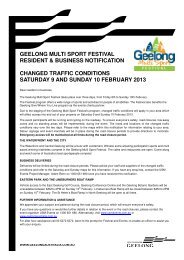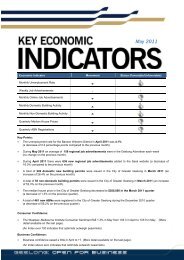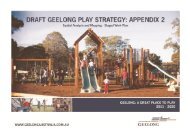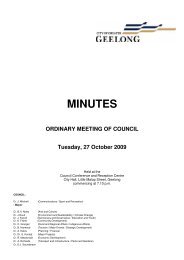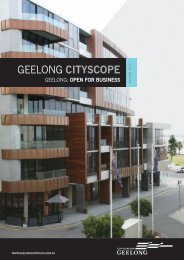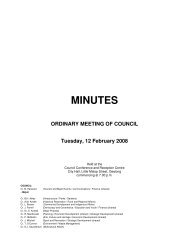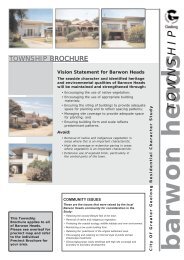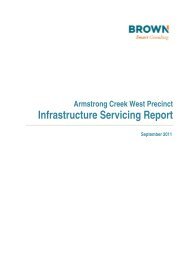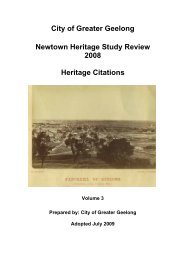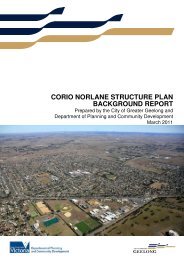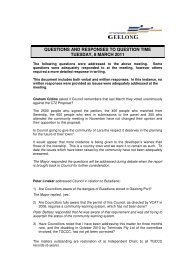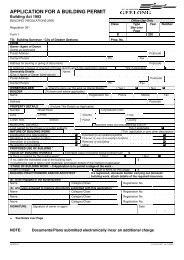ANNUAL REPORT 2007-2008 CITY OF GREATER GEELONG
ANNUAL REPORT 2007-2008 CITY OF GREATER GEELONG
ANNUAL REPORT 2007-2008 CITY OF GREATER GEELONG
Create successful ePaper yourself
Turn your PDF publications into a flip-book with our unique Google optimized e-Paper software.
<strong>CITY</strong> <strong>OF</strong> <strong>GREATER</strong> <strong>GEELONG</strong><br />
NOTES TO THE FINANCIAL <strong>REPORT</strong> FOR THE YEAR ENDED 30 JUNE <strong>2008</strong><br />
1 Significant Accounting Policies (cont’d)<br />
(j) Employee benefits<br />
Wages and salaries<br />
Liabilities for wages and salaries and rostered days off<br />
are recognised and measured as the amount unpaid at<br />
balance date and include appropriate on-costs such<br />
as workers compensation and payroll costs.<br />
Annual leave<br />
Annual leave entitlements are accrued on a pro rata basis<br />
in respect of services provided by employees up to<br />
balance date. Annual Leave expected to be paid within<br />
12 months is measured at nominal value based on the<br />
amount, including appropriate on-costs, expected to be<br />
paid when settled. Annual leave expected to be paid later<br />
that one year has been measured at the present value of<br />
the estimated future cash outflows to be made for these<br />
accrued entitlements. Commonwealth bond rates are<br />
used for discounting future cash flows.<br />
Long service leave<br />
Long service leave entitlements payable are assessed at<br />
balance date having regard to expected employee<br />
remuneration rates on settlement, employment related oncosts<br />
and other factors including accumulated years of<br />
employment, on settlement, and experience of employee<br />
departure per year of service. Long service leave expected<br />
to be paid within 12 months is measured at nominal<br />
value based on the amount expected to be paid when<br />
settled. Long service leave expected to be paid later than<br />
one year has been measured at the present value of the<br />
estimated future cash outflows to be made for these<br />
accrued entitlements. Commonwealth bond rates are<br />
used for discounting future cash flows.<br />
Classification of employee benefits<br />
An employee benefit liability is classified as a current<br />
liability if the Council does not have an unconditional<br />
right to defer settlement of the liability for at least 12<br />
months after the end of the period. This would include<br />
all annual leave and unconditional long service leave<br />
entitlements.<br />
Superannuation<br />
The superannuation expense for the reporting year is the<br />
amount of the statutory contribution the Council makes to<br />
the superannuation plan which provides benefits to its<br />
employees together with any movements<br />
(favourable/unfavourable) in the position of any defined<br />
benefits schemes. Details of these arrangements are<br />
recorded in note 32.<br />
(k) Leases<br />
Finance leases<br />
Leases of assets where substantially all the risks and<br />
benefits incidental to ownership of the asset, but not<br />
the legal ownership, are transferred to the Council are<br />
classified as finance leases. Council holds no finance<br />
leases at balance date.<br />
Operating leases<br />
Lease payments for operating leases are recognised as an<br />
expense in the years in which they are incurred as this<br />
reflects the pattern of benefits derived by the Council.<br />
(l) Refundable Deposits<br />
Amounts received as tender deposits, sundry deposits,<br />
street crossing deposits, hall bonds, and other amounts<br />
controlled by Council which have to be paid back, are<br />
included in the amount disclosed as Refundable Deposits<br />
within current liabilities.<br />
(m) Allocation between current and non-current<br />
In the determination of whether an asset or liability is<br />
current or non-current, consideration is given to the time<br />
when each asset or liability is expected to be settled. The<br />
asset or liability is classified as current if it is expected to<br />
be settled within the next twelve months, being the<br />
Council's operational cycle, or if the Council does not<br />
have an unconditional right to defer settlement of a<br />
liability for at least 12 months after the reporting date.<br />
(n) Web site costs<br />
Costs in relation to websites are charged as an expense in<br />
the period in which they are incurred.<br />
(o) Goods and Services Tax (GST)<br />
Revenues, expenses and assets are recognised net of the<br />
amount of GST, except where the amount of GST incurred<br />
is not recoverable from the Australian Tax Office. In these<br />
circumstances the GST is recognised as part of the cost of<br />
acquisition of the asset or as part of an item of the<br />
expense. Receivables and payables in the balance sheet<br />
are shown inclusive of GST.<br />
Cash flows are presented in the cash flow statement on a<br />
gross basis, except for the GST component of investing<br />
and financing activities, which are disclosed as operating<br />
cash flows.<br />
146



